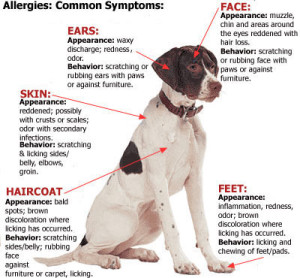Just like us humans, our pets can suffer from allergies. There are 2 types of allergies commonly found in pets. One is food allergies, and the other is environmental and that includes seasonal allergies. Depending on the symptoms, you may be able to determine which your pet has, but the best thing to do is talk to your veterinarian for a proper diagnosis and treatment options. We’ll talk about seasonal allergies here as this is the time of year that many of our four legged friends have trouble.
Seasonal allergy symptoms often have a cycle. For example, itching or skin issue which arise every year in the fall, then goes away a few months later during the colder days of winter may be signs of seasonal and environmental allergies. My cat Mace has seasonal allergies which start with sneezing in August or September, and continue until about February/March (though I think the dry air and dust from the furnace are a contributing factor). Here is a list of some of the symptoms you may see with your pet.
 Skin issues – This encompasses red and inflamed skin, itching, licking, hot spots, hair loss, rubbing of eyes or face, licking of feet. You may also see little bumps, or hives.
Skin issues – This encompasses red and inflamed skin, itching, licking, hot spots, hair loss, rubbing of eyes or face, licking of feet. You may also see little bumps, or hives.- Ears – Chronic ear infections, shaking of head, odour, discharge,
- Respiratory issues – This includes sneezing, coughing, watery eyes, swollen eyes, squinting and runny nose. While these symptoms are not seen as often as the others, it may still be an indicator of an environmental allergy which may or may not be seasonal.
Common allergens include trees, plants, weeds, pollen, grass, etc. Mold, dust spores, and dust mites. Perfumes or fragrances in the air, on laundry, bedding, on you, etc. Cleaning products can contain irritating fragrances, though the active cleaning ingredient is just as likely to cause issues. Fleas and other external parasites, or bug bites and stings. And a big one that gets overlooked a lot is cigarette smoke. Animals suffer from second hand smoke issues as well.
What you can do
- See your vet-Talk to them about options for testing and treatment. They are the experts and have your pet’s best interest in mind.
- Bathing-if it is a tree, pollen, grass allergy, etc, then simply wiping down or bathing
 your pet to reduce the amount of exposure will help them feel better during allergy season.
your pet to reduce the amount of exposure will help them feel better during allergy season. - Washing bedding regularly, vacuuming, and regular changing of the furnace filter will again help to reduce the exposure. Raking the leaves as they fall will help reduce mold spores in the back yard.
- Supplement – Speak to your vet about adding in essential fatty acids to your pets health care plan
- Medicate –Benedryl can be given to pets, but ask your vet first if it is ok with their current health status, and to get a proper dose. You vet may also prescribe prednisone or other corticosteroids.
- Allergy Testing- Again, your vet will be able to get you info about having testing done. Once they allergens are identified, then some labs are able to make an injection that can be given to your pet.
- Elimination trials – rule out food allergies as a contributing factor by using a strict, hypoallergenic diet. The support team at your vet may be able to direct you.
- See a specialist – Your veterinarian will be able to make that recommendation.
- Keep a journal of when allergies start, when they end, and the symptoms to
establish a pattern.
While frustrating, allergies can be managed and if you love your pets as much as I love mine, I know that keeping them comfortable is a high priority. Best of luck.


Good information. I hadn’t thought of that. Will watch her